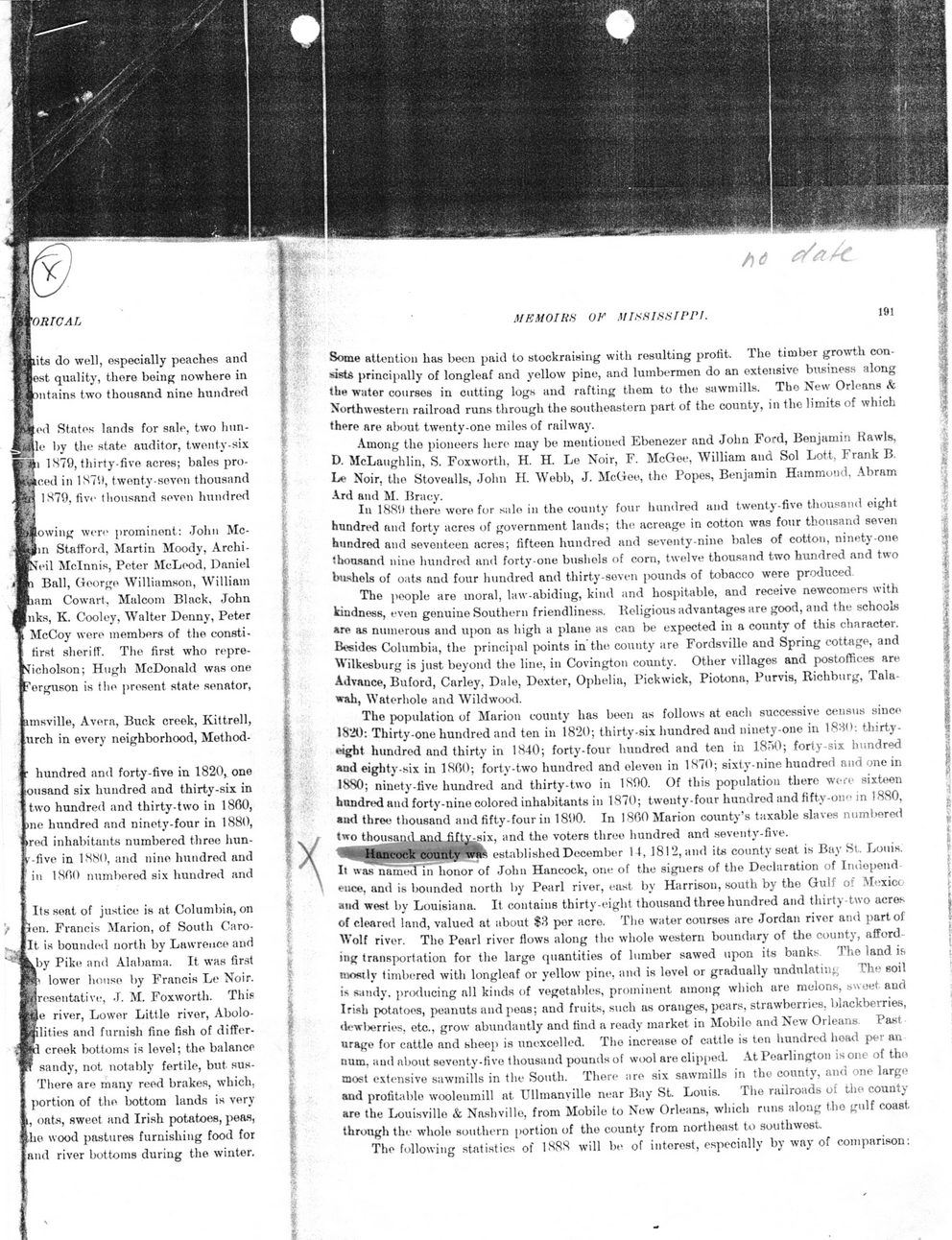This text was obtained via automated optical character recognition.
It has not been edited and may therefore contain several errors.
its do well, especially peaches and est quality, thore being nowhere in mtains two thousand nine hundred oil States lands for sale, two liun-le by the state auditor, twenty-six 1S79, thirty-five acres; bales proceed in 18711, twenty-seven thousand 1S79, five thousand seven hundred owing were prominent: John Mein Stafford, Martin Moody, Archied Mclnnis, Peter McLeod, Daniel 1 Ball, George Williamson, William mm Cowart, Mnlconi Black, John nks, K. Cooley, Walter Denny, Peter McCoy were members of the consti-tirst sheriff. The first who repre-S’ioholson; Hugh McDonald was one Ferguson is the present state senator, itnsville, Avera, Buck creek, Kittrell, urch in every neighborhood, Method- r hundred and forty-five in 1820, one ousand six hundred and thirty-six in two hundred and thirty-two in 1860, me hundred and ninety-four in 1880, >red inhabitants numbered three hunk-five in 1880, and nine hundred and in 1800 numberod six hundred and Its seat of justice is at Columbia, on ion. Francis Marion, of South Caro-It is bounded north by Lawrence and kby Pike and Alabama. It was first lower house by Francis Le Noir. l|jresontative, J. M. Foxworth. This le river, Lower Little river, Abolo-hlities and furnish fine fish of differ-i hi creek liottoms is level; the balance f sandy, not notably fertile, but sus-There are many reed brakes, which, portion of the bottom lands is very , oats, sweet and Irish potatoes, peas, lie wood pastures furnishing food for and river bottoms during the winter. MEMOIRS OF MISSISSIPPI. 191 Some attention has been paid to stockraising with resulting profit. The timber growth consists principally of longleaf and yellow pine, and lumbermen do an extensive business along the water courses in cutting logs and rafting them to the sawmills. Tho New Orleans & Northwestern railroad runs through the southeastern part of the county, in the limits of which there are about twenty-one miles of railway. Among the pioneers here may be mentioned Ebenezer and John Ford, Benjamin Kawls, D. McLaughlin, S. Foxworth, H. H. Le Noir, F. McGee, William and Sol Lott, Frank B. Le Noir. the Stovealls, John II. Webb, J. McGee, tho Popes, Benjamin Hammond, Abram Ard and M. Bracy. In 188!) there were for sale in the county four hundred and twenty-five thousand eight hundred and forty acres of government lands; the acreage in cotton was four thousand seven hundred and seventeen acres; fifteen hundred and seventy-nine bales of cotton, ninety-one thousand nine hundred and forty-one bushels of corn, twelve thousand two hundred and two bushels of oats and four hundred and thirt.y-soven pounds of tobacco were produced. The people are moral, law-abiding, kind and hospitable, and receive newcomers with kindness, even genuine Southern friendliness, lieligious advantages are good, and the schools •re as numerous and upon as high a plane as can be expected in a county of this character. Besides Columbia, the principal points in the county are Fordsville and Spring cottage, and Wilkesburg is just beyond the line, in Covington county. Other villages and postoffices are Advance, Buford, Carley, Dale, Dexter, Ophelia, Pickwick, Piotona, Purvis, Richburg, Tala-wah, Waterhole and Wildwood. The population of Marion county lias been as follows at each successive census since 1820: Thirty-one hundred and ten in 1820; thirty-six hundred and ninety-one in 1830: thirty-«ght hundred and thirty in 1840; forty-four hundred and ten in 1850; forty-six hundred nnd eighty-six in 1800; forty-two hundred and eleven in 1870; sixty-nine hundred and one in INS0; ninety-five hundred and thirty-two in 1800. Of this population there were sixteen hundred and forty-nine colored inhabitants in 1870; twenty-four hundred and fifty-one in 1880, •lid three thousand and fifty-four in 1890. In 1800 Marion county’s taxable slaves numbered two thousand and fiftj.siv, and the voters three hundred and seventy-five. Qjtaeock count* wy established December 1 1, 1812, and its county seat is Bay St.. Louis. It was named in honor of John Hancock, one of the signers of the Declaration of Independ ei»ce, and is bounded north by Pearl river, east by Harrison, south by the Gulf of Mexic< »nd west by Louisiana. It contains thirty-eight thousand three hundred and thirty-two acres of cleared land, valued at about $3 per acre. Tho water courses are Jordan river and part of Wolf river. Tho Pearl river flows along the whole western boundary of the county, afford ing transportation for tho large quantities of lumber sawed upon its banks The land is mostly timbered with longleaf or yellow pine, and is level or gradually undulating The soil is sandy, pnxlucing all kinds of vegetables, prominent among which are melons, sweet and Irish potatoes, peanuts and peas; and fruits, such as oranges, pears, strawberries, blackberries, dewberries, etc., grow abundantly and find a ready market in Mobilo and New Orleans. Past urage for cattle and sheep is unexcelled. Tho increase of cattle is ten hundred hoad per an num. and about seventy-five thousand pounds of wool are clipped. At Pearlington is one of the most extensive sawmills in the South. There are six sawmills in the county, and one large and profitable wooloumill at Ullmanyille near Bay St. Louis. The railroads of the county are the Louisvillo & Nashvillo, from Mobile to New Orleans, which runs along tho gulf coast, through the whole southern portion of the county from northeast to southwost. The following statistics of 1888 will be of intorest, especially by way of comparison:

Hancock County 1 Memoirs-of-Mississippi-191-193-(028)